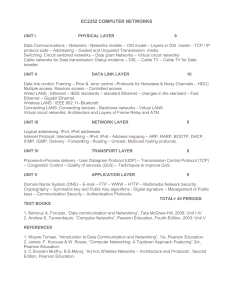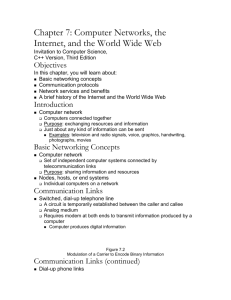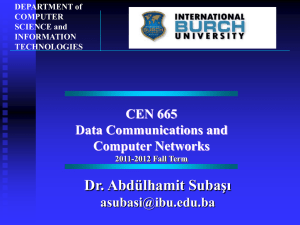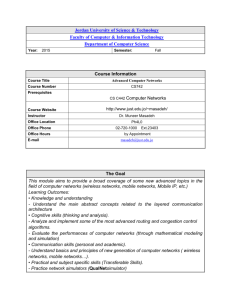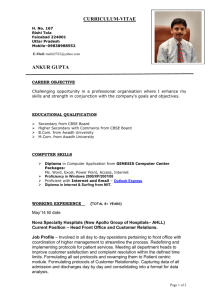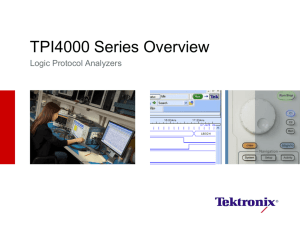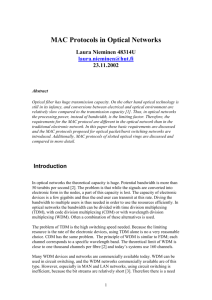7th Semester Course Outcomes
advertisement
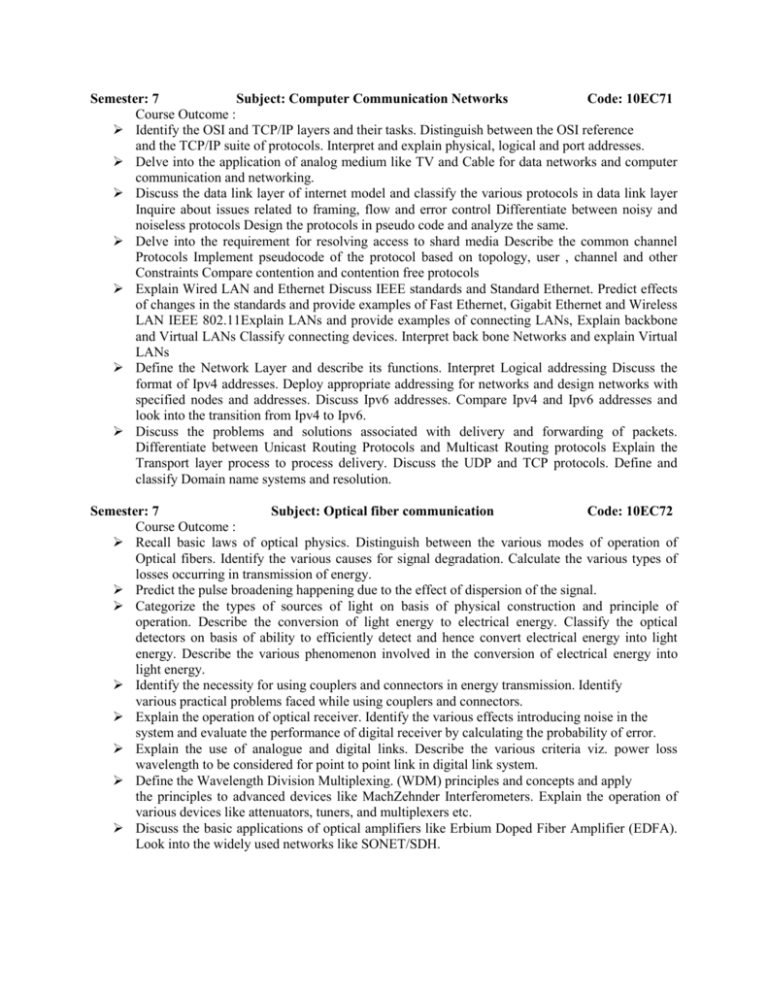
Semester: 7 Subject: Computer Communication Networks Code: 10EC71 Course Outcome : Identify the OSI and TCP/IP layers and their tasks. Distinguish between the OSI reference and the TCP/IP suite of protocols. Interpret and explain physical, logical and port addresses. Delve into the application of analog medium like TV and Cable for data networks and computer communication and networking. Discuss the data link layer of internet model and classify the various protocols in data link layer Inquire about issues related to framing, flow and error control Differentiate between noisy and noiseless protocols Design the protocols in pseudo code and analyze the same. Delve into the requirement for resolving access to shard media Describe the common channel Protocols Implement pseudocode of the protocol based on topology, user , channel and other Constraints Compare contention and contention free protocols Explain Wired LAN and Ethernet Discuss IEEE standards and Standard Ethernet. Predict effects of changes in the standards and provide examples of Fast Ethernet, Gigabit Ethernet and Wireless LAN IEEE 802.11Explain LANs and provide examples of connecting LANs, Explain backbone and Virtual LANs Classify connecting devices. Interpret back bone Networks and explain Virtual LANs Define the Network Layer and describe its functions. Interpret Logical addressing Discuss the format of Ipv4 addresses. Deploy appropriate addressing for networks and design networks with specified nodes and addresses. Discuss Ipv6 addresses. Compare Ipv4 and Ipv6 addresses and look into the transition from Ipv4 to Ipv6. Discuss the problems and solutions associated with delivery and forwarding of packets. Differentiate between Unicast Routing Protocols and Multicast Routing protocols Explain the Transport layer process to process delivery. Discuss the UDP and TCP protocols. Define and classify Domain name systems and resolution. Semester: 7 Subject: Optical fiber communication Code: 10EC72 Course Outcome : Recall basic laws of optical physics. Distinguish between the various modes of operation of Optical fibers. Identify the various causes for signal degradation. Calculate the various types of losses occurring in transmission of energy. Predict the pulse broadening happening due to the effect of dispersion of the signal. Categorize the types of sources of light on basis of physical construction and principle of operation. Describe the conversion of light energy to electrical energy. Classify the optical detectors on basis of ability to efficiently detect and hence convert electrical energy into light energy. Describe the various phenomenon involved in the conversion of electrical energy into light energy. Identify the necessity for using couplers and connectors in energy transmission. Identify various practical problems faced while using couplers and connectors. Explain the operation of optical receiver. Identify the various effects introducing noise in the system and evaluate the performance of digital receiver by calculating the probability of error. Explain the use of analogue and digital links. Describe the various criteria viz. power loss wavelength to be considered for point to point link in digital link system. Define the Wavelength Division Multiplexing. (WDM) principles and concepts and apply the principles to advanced devices like MachZehnder Interferometers. Explain the operation of various devices like attenuators, tuners, and multiplexers etc. Discuss the basic applications of optical amplifiers like Erbium Doped Fiber Amplifier (EDFA). Look into the widely used networks like SONET/SDH. Semester: 7 Subject: Power Electronics Code: 10EC73 Course Outcome : Explain the applications of power electronics and describe control characteristics of various power semiconductor devices. Explain construction and working of power transistors and delve into the switching characteristics of power transistors. Categorize different types of thyristors and describe construction of Silicon Controlled Rectifier SCR. Analyze turnon, turnoff and gate characteristics of SCR. Demonstrate the operation and characteristics of controlled rectifiers and derive the expressions for output voltage and load current. List the types of thyristor (commutation) turnoff techniques and derive equations for the commutation circuit component. Explain the need and function of AC voltage controllers. Design AC voltage controller for resistive and inductive loads. Describe the working principle of step up and step down choppers with RL loads. Design series inverter with different circuit arrangements. Explain principle of operation of 3 bridge inverter. Semester: 7 Subject: DSP Architecture and Algorithms Code: 10EC74 Course Outcome : Recall the fundamental principles of signal processing. Describe the basic concepts and properties of sampling rate alteration. List the basic architectural features of DSP devices. Identify various building blocks of programmable digital signal processor (DSPr). Analyze the desirable features of programmable DSPr building blocks in terms of their hardware realization. Compare fixed point and floating point DSPs. Describe architecture, software, and hardware features of TMS320C54xx processor. Demonstrate assembly level programming with an example. Explain the Qnotation. Implement finite impulse response (FIR) and infinite impulse response (IIR) filters on TMS320C54xx. Compare the implementation of interpolation and decimation on TMS320C54xx. Recall discrete Fourier transform (DFT) pair. Show the steps involved in developing fast Fourier transform (FFT) using decimation in time (DIT) domain. Develop TMS320C54xx assembly code to find DFT of a sequence. Recall the interfacing of memory and I/O to programmable devices. Describe direct memory access (DMA) and interrupts of TMS320C54xx with suitable example. Explain synchronous serial interface and multichannel buffered serial port (McBSP) of DSPr device. Explain and demonstrate the programming of interfacing CODEC. Semester: 7 Subject: Real Time Operating Systems Code: 10EC762 Course Outcome : Define Real time System. Provide a general introduction to computer control and to embedded computer systems. Discuss how real time systems can be classified. Explain and compare basic computer configuration used for control. Explain the importance of the human computer interface. Describe the major features of microprocessors. Explain the standard communication. Methodologies. Describe the standard interfacing techniques. Explain and prioritize the major requirements for a real time language. Describe the features that assist in the construction of safe, reliable software. Explain why we use a real time operating system (RTOS). Describe the problem of sharing resources and explain several techniques for providing mutual exclusion. Describe how to approach the planning and design of a computer based system. Illustrate some of the problems associated with real time, multitasking software. Describe how specification, design and implementation can be considered as a process of modeling.
